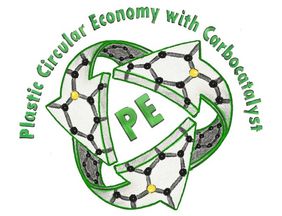UniSysCat group leaders Majd Al-Naji and Markus Antonietti published the paper “Turning Polyethylene Waste to Hydrocarbons Using a Sustainable Acidic Carbocatalyst”, which was also featured on the cover of the journal “ChemSusChem” (see picture, for the full cover click here).
The researchers developed a metal-free acidic carbocatalyst with dual functionalities using a byproduct from the paper industry (Na-lignosulfonate) as a carbon source. This catalyst has shown excellent performance in breaking down plastic waste; in this case high-density polyethylene (HDPE) and a mixture of HDPE and low-density polyethylene (LDPE), into n-alkanes and n-alkenes. The sulfur-rich carbonaceous structure and metal-free nature of this acidic carbocatalyst make it resistant to typical catalyst poisons, such as water or adhered food leftovers, which makes it promising candidate to treat real waste from the “yellow bag”. The carbocatalyst is low-cost, readily available, and was already produced in kg scale as it can be simply extruded. It is stable at high temperatures, possesses a high surface area as well as exhibiting a hierarchical pore structure and containing acidic and hydrogen-transfer sites. This research provides a route towards a closed plastic loop and the transition toward more sustainable societies.
If you’re interested in this topic, you might also enjoy this conference where Majd is also speaking.



